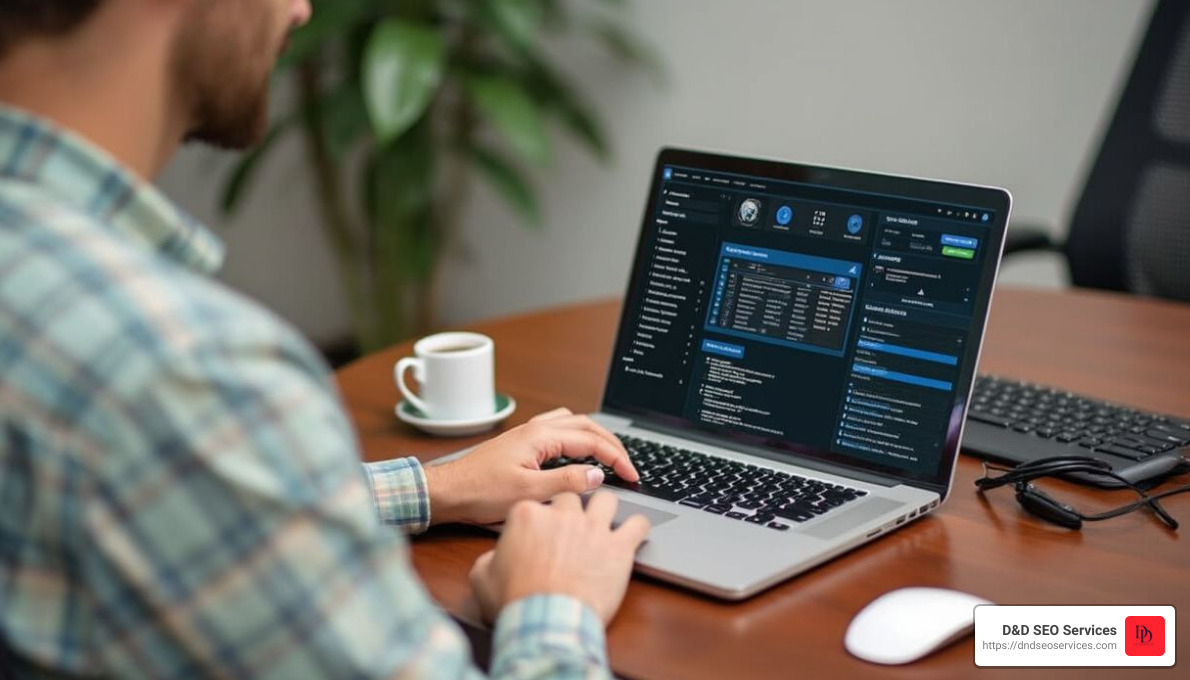Why Mobile Local SEO is Crucial for Your Business
If you’re looking to attract more local customers and grow your business, mobile local SEO is a game-changer. It’s about optimizing your online presence so your business shows up in local searches done on mobile devices.
Here’s what you need to know right off the bat:
- More People Use Mobile: Over half of all local searches happen on mobile devices.
- Google’s Mobile-First Indexing: Google indexes and ranks the mobile version of your site first.
- Improves User Experience: A mobile-friendly site means better user satisfaction and higher conversion rates.
Mobile local SEO is not just a trend; it’s essential for staying competitive today. Your target audience relies heavily on mobile searches to find local businesses like yours. Ignoring this can mean missing out on a large chunk of potential customers.
I’m Danielle Birriel, founder and SEO visionary at D&D SEO Services. With over a decade of experience in mobile local SEO, my team and I help businesses like yours drive real results. We focus on enhancing online visibility, attracting local customers, and boosting revenue through mobile optimization.
Next, we’ll dive deeper into understanding what mobile local SEO is and why it’s so vital for your business success.
Understanding Mobile Local SEO
What is Mobile Local SEO?
Mobile Local SEO is about optimizing your online presence to attract more business from relevant local searches on mobile devices like smartphones and tablets. It’s a combination of mobile SEO and local SEO. Given that 64% of searches are now conducted on mobile devices, ensuring your website is mobile-friendly is crucial.
The Rise of Mobile Devices
Over the past few years, mobile devices have become the primary means for people to search online. This shift is due to the convenience and accessibility that smartphones and tablets offer. With mobile technology, users can search for local businesses anytime, anywhere.
Local Search: The Game Changer
Local search refers to users looking for businesses or services within a specific geographical area. For example, someone might search for a “coffee shop near me” while walking downtown. Mobile devices, equipped with GPS, make it easy for search engines like Google to provide location-specific results without the user needing to type their location.
User Behavior on Mobile Devices
User behavior on mobile devices differs significantly from desktop searches. Here are some key points:
- Quick Queries: Mobile users often perform quick searches on the go. They look for immediate answers and solutions.
- Voice Search: The use of voice search has increased by 146% from 2019 to 2023. People often use voice search in the form of questions, such as “Where is the nearest gas station?”
- “Near Me” Searches: Searches like “open near me” have skyrocketed by 400% year over year. This indicates a strong intent to find local businesses quickly.
Why Mobile Local SEO Matters
Mobile local SEO is vital because it aligns with how users search and interact with businesses today. According to Google, 60% of smartphone users contact businesses directly from local search results. This means optimizing for mobile local SEO can lead to more calls, visits, and ultimately, more sales.
By understanding the importance of mobile local SEO, businesses can better tailor their strategies to meet the needs of their audience and stand out in local search results.
Next, we’ll explore the key elements that make up effective mobile local SEO and how to implement them for your business.
Key Elements of Mobile Local SEO
To master mobile local SEO, you’ll need to focus on several key elements. These elements ensure your website is not only visible in local search results but also provides a seamless experience for mobile users. Let’s dive into the essential components:
Responsive Design
Responsive web design (RWD) is crucial. It ensures your website adjusts to any screen size, from desktops to smartphones. This flexibility means users get a consistent experience no matter what device they use.
Consider this: a study by Google found that 61% of users are unlikely to return to a mobile site they had trouble accessing. Even more, 40% visit a competitor’s site instead.
Key Takeaway: Implementing RWD eliminates the need for a separate mobile site, ensuring consistency and improving user satisfaction.
Speed Optimization
Mobile users expect quick load times. In fact, 53% of mobile site visitors will leave a page that takes longer than three seconds to load. Speed optimization techniques include:
- Compressing images and videos
- Minimizing code (HTML, CSS, JavaScript)
- Leveraging browser caching
- Utilizing content delivery networks (CDNs)
Key Takeaway: Faster load times reduce bounce rates and improve user engagement, which are critical factors for search engine rankings.
User Experience (UX)
A positive user experience (UX) on mobile devices is essential. This includes:
- Designing for touch rather than mouse clicks
- Ensuring buttons and links are easy to interact with
- Creating intuitive navigation
- Formatting text for readability without zooming
A good mobile UX encourages longer site visits and interaction, which signals to search engines that your site provides value.
Key Takeaway: Simplify your design and make navigation thumb-friendly to improve user satisfaction and SEO performance.
Structured Data
Structured data helps search engines understand your site’s content better. This can improve your visibility in search results through rich snippets, which include additional information like star ratings, prices, or availability.
For example, a local restaurant might use structured data to show its menu, hours of operation, and customer reviews directly in search results.
Key Takeaway: Implementing structured data can significantly improve your click-through rates and overall search visibility.
Local SEO Optimization
For businesses that operate locally, local SEO optimization is a must. This involves:
- Using local keywords
- Creating a Google My Business listing
- Ensuring consistent NAP (Name, Address, Phone number) information across the web
- Adding local content and mobile-optimized location maps
Key Takeaway: Local SEO optimization helps you appear in local search results, which is crucial for attracting nearby customers.
By focusing on these key elements, you can effectively improve your mobile local SEO strategy, making it easier for potential customers to find and engage with your business.
Next, we’ll look at the best practices for combining mobile SEO and local SEO to maximize your online presence.
Mobile SEO Best Practices
When it comes to mobile local SEO, following best practices can make a huge difference in how your site ranks and how users interact with it. Here are the most important strategies you should focus on:
Responsive Web Design
Responsive Web Design (RWD) ensures your website looks and works well on any device. Instead of creating a separate mobile site, RWD uses flexible layouts and images that adjust to fit different screen sizes.
Why it matters: Google favors sites that provide a consistent experience across all devices. Plus, users are more likely to stay on a site that’s easy to steer, reducing bounce rates.
Tip: Use tools like Google’s Mobile-Friendly Test to check if your site is responsive.
Speed Optimization
Speed is crucial. Mobile users expect quick load times, and even a few seconds of delay can lead to higher bounce rates.
Techniques for Speed Optimization:
– Compress images and videos: Reducing file sizes without losing quality can significantly speed up load times.
– Minimize code: Clean up your HTML, CSS, and JavaScript to make your site leaner.
– Leverage browser caching: Store static resources locally to reduce load times on repeat visits.
– Use a Content Delivery Network (CDN): Distribute content across various servers to improve load times globally.
Fact: According to Google, 53% of mobile users leave a site that takes longer than 3 seconds to load.
User Experience (UX)
A positive user experience is essential for keeping visitors on your site and encouraging them to engage with your content.
Key UX Elements:
– Touch-friendly design: Make sure buttons and links are easy to tap.
– Readable text: Ensure that text is large enough to read without zooming.
– Simple navigation: Keep menus straightforward and easy to use.
Quote: “A good mobile experience is about more than just a pretty design. It’s about creating an intuitive, easy-to-steer environment.” – Rand Fishkin
Structured Data
Structured data helps search engines understand your content better. This can lead to rich snippets in search results, which are more eye-catching and can improve click-through rates.
Types of Structured Data:
– Local business schema: Provides search engines with your business details (name, address, phone number).
– Product schema: Offers details about your products, such as price and availability.
– Review schema: Displays star ratings and reviews in search results.
Tip: Use Google’s Structured Data Testing Tool to ensure your structured data is correctly implemented.
Mobile-Friendly Navigation
Navigation should be simple and intuitive. Mobile users don’t want to dig through complex menus to find what they need.
Best Practices for Mobile Navigation:
– Simplify menus: Use a clear hierarchy and avoid deep dropdowns.
– Sticky headers: Keep important navigation options accessible as users scroll.
– Large touch targets: Make sure buttons and links are large enough to tap easily.
Example: Apple moved the navigation bar to the bottom of the screen in their Safari browser, making it easier for users to reach with their thumbs.
By implementing these best practices, you’ll provide a better experience for mobile users and improve your mobile local SEO.
Next, we’ll explore how mobile SEO can directly improve your local search results.
How Mobile SEO Improves Local Search Results
Mobile-Friendly Design
A mobile-friendly design is crucial for local SEO. Websites that are optimized for mobile devices rank higher in search results. Google prioritizes mobile-friendly sites because they offer a better user experience.
Fact: According to recent studies, 64% of all searches are conducted on mobile devices. This means if your website isn’t mobile-friendly, you’re missing out on a lot of potential traffic.
Click-to-Call Functionality
Click-to-call functionality allows users to call your business directly from search results. This feature is essential for local businesses because it makes it easy for potential customers to reach you.
Example: Imagine you’re a local pizza shop. A customer searches for “pizza near me” on their phone. They find your business and click a button to call and place an order. This convenience can significantly increase your sales.
Location Data
Search engines use location data from GPS and IP addresses to provide relevant local search results. If your business has accurate location data, it will show up in searches from nearby users.
Tip: Ensure your business’s name, address, and phone number (NAP) are consistent across all online directories. This consistency helps search engines verify your location and improve your local ranking.
Mobile Speed
Mobile speed is a critical factor for both user experience and SEO. Slow-loading websites frustrate users and lead to higher bounce rates. Google considers page speed as a ranking factor, so faster sites perform better in search results.
Statistic: Google reports that 53% of mobile site visitors leave a page that takes longer than three seconds to load. Optimizing your site for speed can keep users engaged and improve your rankings.
User Reviews
User reviews and ratings can boost your visibility and credibility in local search results. Positive reviews signal to search engines that your business is trustworthy and relevant.
Case Study: Reliable Couriers, a delivery service, saw a significant increase in local search rankings after encouraging customers to leave reviews. By integrating a simple text message asking for feedback, they quickly gathered positive reviews and improved their local SEO.
By focusing on these key elements, you can improve your mobile local SEO and attract more local customers. Next, we’ll discuss the role of mobile-first indexing in your SEO strategy.
Optimizing Your Website for Mobile Local SEO
To rank well in local search results, it’s crucial to optimize your website for mobile local SEO. Here are the key areas to focus on:
Responsive Design
Responsive design is essential. It ensures your website looks great and functions well on any device, whether it’s a desktop, tablet, or smartphone.
Using responsive web design (RWD), your site automatically adjusts its layout and content to fit the screen size. This eliminates the need for a separate mobile site and keeps the user experience consistent.
Example: A local bakery saw a 30% increase in mobile traffic after switching to a responsive design. Customers loved the seamless experience across devices, which led to more online orders.
Mobile Speed
Speed is critical for mobile users. Slow load times can drive visitors away and hurt your rankings.
To improve your mobile speed, compress images, minimize code (HTML, CSS, JavaScript), and leverage browser caching. Tools like Google PageSpeed Insights can help you identify areas for improvement.
Statistic: According to Google, 53% of mobile site visitors leave a page that takes longer than three seconds to load.
User Experience
A good user experience (UX) is vital for keeping visitors on your site. Design for touch, not clicks, with buttons and links that are easy to tap. Ensure navigation is intuitive and content is readable without zooming.
Tip: Use large fonts and thumb-friendly buttons. Avoid small text and tiny buttons that frustrate users.
Example: A local gym improved its mobile UX by adding clear, easy-to-tap buttons for class bookings. This led to a 20% increase in mobile sign-ups.
Structured Data
Structured data helps search engines understand your content better. Use schema markup to improve your visibility in search results and enable rich snippets like star ratings and prices.
Benefit: Implementing structured data can improve your click-through rates by making your listings more attractive.
Example: A local restaurant added structured data for its menu items. This resulted in rich snippets appearing in search results, which boosted their click-through rates by 15%.
Local SEO
For local businesses, optimizing for local search is crucial. Use local keywords, create a Google My Business listing, and ensure your NAP (Name, Address, Phone number) is consistent across the web.
Tip: Include local content and mobile-optimized location maps to improve user experience and SEO.
Example: A lawn care company in Wisconsin used local keywords like “lawn care Wisconsin” and saw a significant increase in local search traffic.
By focusing on these areas, you can improve your mobile local SEO and attract more local customers. Next, we’ll discuss the role of mobile-first indexing in your SEO strategy.
The Role of Mobile-First Indexing
Google’s mobile-first indexing is a game-changer for SEO. But what does it mean? Simply put, Google now primarily uses the mobile version of a site for indexing and ranking.
Why Mobile-First Indexing?
Mobile-first indexing means that the mobile version of your website is the starting point for what Google includes in their index and the baseline for how they determine rankings. If your site isn’t optimized for mobile, it can seriously hurt your search engine rankings.
Ranking Factor
Mobile-first indexing is a significant ranking factor. Google looks at the mobile version of your site to decide where you should appear in search results. If your mobile site is slow or hard to steer, your rankings will suffer.
Fact: Google rolled out mobile-first indexing in early 2018. Since then, the mobile version of your site has become crucial for SEO.
Mobile vs. Desktop
Before mobile-first indexing, Google used the desktop version of your site for indexing. This meant that your mobile site could be less comprehensive and still rank well. Now, the mobile version is what counts.
Example: A restaurant in New York saw a drop in their rankings because their mobile site was not optimized. Once they improved their mobile site, their rankings and customer visits increased.
Key Takeaways
- Optimize for Mobile: Ensure your mobile site is fast, easy to steer, and provides a good user experience.
- Consistent Content: Make sure your mobile and desktop sites have the same content. Don’t strip down your mobile site.
- Check Performance: Use tools like Google’s Mobile-Friendly Test and PageSpeed Insights to check your site’s mobile performance.
By focusing on mobile-first indexing, you can improve your mobile local SEO and keep your site ranking high. Next, we’ll explore how to leverage micro-moments for local SEO success.
Leveraging Micro-Moments for Local SEO
Micro-moments are those quick instances when people turn to their mobile devices to learn, do, or buy something instantly. Google coined this term to highlight how user behavior has shifted towards seeking immediate answers. Understanding and leveraging these micro-moments can significantly boost your mobile local SEO.
User Behavior and Instant Access
When people have a question or need, they often turn to their smartphones for instant answers. These moments are brief but crucial. For example, someone might search for “best pizza near me” while standing on a street corner. They want quick, relevant results.
Fact: According to Google, 62% of all time spent on digital media is on mobile devices. This means most of your potential customers are searching on the go.
Local Search and Mobile Devices
Local searches often happen in these micro-moments. Whether it’s finding a nearby restaurant, a gas station, or a florist, people rely on their phones for local information. This makes optimizing for local SEO on mobile devices essential.
Statistic: “Open near me” searches have increased by 400% YoY from September 2019 to August 2021. This shows a massive shift towards local searches on mobile devices.
Capturing Micro-Moments
To capture these micro-moments, your local business needs to ensure that your information is easily accessible and up-to-date. Here are some tips:
- Accurate Information: Make sure your NAP (Name, Address, Phone number) is consistent across all platforms.
- Quick Load Times: A slow website can lose you customers. Compress images and optimize code to speed up your mobile site.
- Responsive Design: Your site should look great on any device. Use responsive web design to adapt to different screen sizes.
Quote: “Consumers crave instant results, and businesses should view it as a challenge to satisfy consumers in these ‘need-to-know’ moments.” – Google
Examples and Case Studies
Consider a local coffee shop that optimized its mobile site for speed and included a “click-to-call” button. They noticed a 30% increase in calls and visits during peak morning hours. This is a perfect example of leveraging micro-moments for local SEO success.
Case Study: A florist in Irving optimized their mobile site and saw a 20% increase in local searches leading to in-store visits. They achieved this by ensuring their site loaded quickly and provided easy navigation.
Tools and Resources
To make the most of micro-moments, use tools like:
- Google’s Mobile-Friendly Test: Check how easily a visitor can use your page on a mobile device.
- PageSpeed Insights: Analyze your mobile site speed and get suggestions for improvement.
By focusing on these micro-moments, you can improve your mobile local SEO and attract more local customers. Next, we’ll answer some frequently asked questions about mobile local SEO.
Frequently Asked Questions about Mobile Local SEO
Can I do SEO on mobile?
Absolutely, you can perform SEO on mobile devices! Mobile SEO involves optimizing your website so it performs well on smartphones and tablets. Given that 64% of searches are now conducted on mobile devices, it’s crucial for businesses to ensure their websites are mobile-friendly.
Mobile SEO focuses on aspects like responsive design, fast load times, and easy navigation. Tools like Google’s Mobile-Friendly Test can help you see how well your site performs on mobile devices.
How is mobile SEO different from desktop SEO?
Mobile SEO and desktop SEO share similar goals but differ in execution due to the unique characteristics of mobile devices. Here are some key differences:
- Screen Size: Mobile devices have smaller screens, requiring a design that fits and functions well on these screens.
- SERP Layout: Mobile search results pages (SERPs) show fewer results than desktop SERPs and often include images or videos.
- User Behavior: Mobile users tend to perform shorter queries and often look for local results. For instance, searches like “restaurants near me” have surged by 400% YoY.
Optimizing for mobile local SEO means considering these factors to improve user experience and improve search rankings.
Is mobile friendliness important for SEO?
Yes, mobile friendliness is crucial for SEO. Google uses a mobile-first indexing approach, meaning it primarily uses the mobile version of your site for indexing and ranking. If your website isn’t optimized for mobile, it could negatively impact your search rankings.
Here are some reasons why mobile friendliness is essential:
- Ranking Signal: Google and Bing prioritize mobile-friendly websites in their search results.
- User Experience: A mobile-friendly site ensures a smooth experience for users, leading to higher engagement and lower bounce rates.
- Local Search: With 82% of smartphone users using search to find local businesses, having a mobile-optimized site makes it easier for potential customers to find you.
By following best practices for mobile local SEO, you can improve your site’s visibility and attract more local customers.
Next, we’ll conclude with how D&D SEO Services can help you master mobile local SEO for your business.
Conclusion
At D&D SEO Services, we understand the unique challenges and opportunities that come with mobile local SEO. As local businesses strive to reach more customers, having a mobile-optimized presence is no longer optional—it’s essential.
Mobile local SEO helps businesses appear prominently in local search results, which is crucial given that 82% of smartphone users use search to find local businesses. This means your potential customers are already looking for services like yours, and a well-optimized mobile site ensures they find you quickly and easily.
Our approach at D&D SEO Services combines AI-driven solutions and personalized strategies to lift your local SEO efforts. We focus on:
- Responsive Design: Ensuring your website looks great and functions well on all devices.
- Speed Optimization: Making sure your site loads quickly, reducing bounce rates and improving user experience.
- User Experience: Creating an intuitive and engaging experience for mobile users.
- Local SEO Optimization: Using targeted keywords, accurate business listings, and local backlinks to boost your visibility.
By partnering with us, you’ll benefit from our comprehensive expertise and custom strategies designed to make your business stand out in local search results.
Ready to take your local SEO to the next level? Contact us today to get started on your journey to online success!
By focusing on mobile local SEO, D&D SEO Services helps local businesses not only improve their online visibility but also build stronger connections with their target audience. Our personalized strategies ensure that your business stands out in an increasingly competitive digital landscape.









